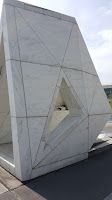“Whatever its flaws, the United Nations is still the only institution that brings together all the countries of the world.”
Samantha Power
Mankind has long dreamt of an organized group that enforces what is beneficial and just, notwithstanding the will of the most powerful. In 15th-century literature that hope was fulfilled with tales of King Arthur and his Knights of the Round Table. George Lucas’ 1977 Star Wars introduced a universe with Jedi who invoked the power of The Force to oppose those who would impose control of the population. The United Nations is the modern incarnation of these mythical groups and the factual history of the international organization that currently holds the position as the world’s conscience is worthy of a visit when in New York City.
At the end of The Great War, WWI, the 1919 Treaty of Versailles brought the League of Nations into being. Ratified by 42 nations, the league was created to maintain peace, protect borders and improve post-war living conditions. Originally successful, it was disbanded in 1946.
President Roosevelt and Prime Minister Churchill declared the creation of the United Nations as a peacekeeping force at the end of WWII in 1945. Twenty-six countries ratified the organization with commitments from additional countries. Headquarters were established in New York with satellite offices in Geneva, Nairobi and Vienna with Arabic, Chinese, English, French, Russian, and Spanish as the official languages. The International Court of Justice is located at The Hague in the Netherlands. Five main divisions, the General Assembly, the Security Council, the Economic and Social Council, the Trusteeship Council and the Secretariat are located in NY. The Security Council’s recommendation and the consent of 2/3 of the General Assembly are necessary for the admission of new countries.
The 17-acre complex was completed in 1951 near the East River. Inside a perimeter fence the flags of the member nations and the UN Flag are featured, in alphabetical order. The compound is not considered part of the United States but is instead deemed “extraterritorial”.
Tours are offered weekdays between 9 AM and 4:45 PM. All tours are guided and last up to one-hour. Take special note of the blue, gold and green General Assembly Hall. The hall is 165-ft. in length by 115-ft. wide. Six members of each delegation are seated facing an elevated podium. The hall also houses interpreters and photography booths and a board used to display the tabulation of votes on various issues. Over it all the United Nation seal, adopted in 1947, is suspended over the rostrum.
One of the most exciting aspects of interior and exterior tours is viewing the permanent United Nations art collection. The artworks represent the beliefs, ideals and commitment of the organization as exemplified by a variety of artistic genres. Items in the collection are gifts from the member nations. Each nation is allowed to present one gift and they are responsible for its placement.
Highlights of the art collection include:
Dag Hammarskjöld was United Nations Secretary-General from 1953-1961. In honor of his dedicated service a 15-ft. by 12-ft. stained glass window by Marc Chagall was donated in 1964. It symbolizes the ideals of love and peace that he promoted. Chagall wanted his “window of peace” to be felt as well as seen.
In 1985, on the organization’s 40th anniversary, Nancy Reagan donated The Golden Rule on behalf of the United States. The mosaic, crafted by Venetian artists, replicates a Norman Rockwell painting.
A Security Council entrance wall is adorned with a large copy of Picasso’s Guernica, considered one of the greatest anti-war paintings in the world, Jacqueline de la Baume Dürrbach created the tapestry in 1955. The 11.5-ft. by 25.5-ft. tapestry is on loan from the Rockefeller family.
The United Nations Association of Japan gifted the organization with the Japanese Peace Bell in 1954. It was cast from coins from individuals in 60 countries and is encased in a cypress wood Shinto shrine. The bell is rung on the first day of spring and on September 21st, the opening day of the General Assembly.
On December 4, 1959 The Soviet Union presented a bronze sculpture, Let Us Beat Our Swords into Ploughshares, to the UN. It depicts a man with a hammer in one hand and a sword in the other to represent mankind’s longing for peace by turning weapons of war into peacetime implements.
One of the most photographed artworks on Visitors’ Plaza is the Knotted Gun Sculpture by Swedish artist Carl Fredrik Reuterswärd. The gun, a .357 Magnum revolver, has a barrel with a knot in it. The official name of the sculpture is Non Violence and the artist created it after the death of his friend John Lennon. The country of Luxembourg gifted it to the United Nations in 1988.
Fifteen years ago the UN General Assembly voted to construct a permanent monument to commemorate the victims of the transatlantic slave trade and enslavement. The design was selected by competition and the chosen architect was Haitian American Rodney Leon. The Ark of Return was funded by the member states. The monument was dedicated on March 25, 2015, the International Day of Remembrance of the Victims of Slavery and the Transatlantic Slave Trade. It too is in Visitors’ Plaza.
The sculptural diorama is comprised of three components. Acknowledge the Tragedy is a three-dimensional map that features the slave trade international routes. Section two, Consider the Legacy, depicts a full-sized African lying prone before a wall inscribed with pictures of a Middle Passage slave ship interior. The final section, Lest We Forget, contains a triangular pool where visitors are invited to reflect on the slave trade’s legacy, modern racism and prejudice.
“No nation can make itself secure by seeking supremacy over all others. We all share responsibility for each other's security, and only by working to make each other secure can we hope to achieve lasting security for ourselves.” Kofi Annan












